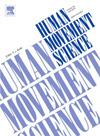The use of motor imagery in 6–7-year-old children is not robust: Evidence from two motor imagery tasks
IF 1.9
3区 心理学
Q4 NEUROSCIENCES
引用次数: 0
Abstract
Motor imagery (MI) is a dynamic cognitive process in which an individual mentally simulates a movement without an external demonstration of the actual movement. The ability of adults to use MI has been well documented, but the ability of children to use MI is less clear. The current study examined age-related differences in MI using two MI tasks, the hand laterality recognition (HLR) and bimanual motor (BM) tasks, in 6–13-year-old typically developing children. Biomechanical constraint effects in the HLR task and the ovalization index (OI) of the imagery condition and the imagery coupling effect in the BM task, among others, were quantitative indicators of the ability to use MI. Significant biomechanical constraint effects in the HLR task and significant imagery coupling effects in the BM task were not observed in 6–7-year-old children, but were evident in 8–13-year-old children, indicating that the use of MI in 6–7-year-old children is not robust in either MI task. There was significant shortening of correct reaction time and improvement of accuracy in the HLR task with increasing age, but there was no significant age difference or correlation with age in the imagery coupling effect in the BM task. Therefore, the results suggest that MI ability as measured by the HLR task shows age-related improvements between 6 and 13 years of age, whereas MI ability, as measured by the BM task, does not show significant age-related differences over the same period.
6 - 7岁儿童运动意象的使用并不稳健:来自两个运动意象任务的证据
运动想象(MI)是一个动态的认知过程,在这个过程中,个体在心理上模拟一个运动,而不需要外部的实际运动演示。成人使用心肌梗死的能力已被充分证明,但儿童使用心肌梗死的能力尚不清楚。目前的研究在6 - 13岁的典型发育儿童中使用两种MI任务,即手侧性识别(HLR)和双手运动(BM)任务来检查MI的年龄相关差异。HLR任务中的生物力学约束效应、图像条件的成核指数(OI)和BM任务中的图像耦合效应等是MI使用能力的定量指标。HLR任务中的生物力学约束效应和BM任务中的图像耦合效应在6 - 7岁儿童中未观察到,但在8 - 13岁儿童中表现明显。这表明6 - 7岁儿童使用MI在两项MI任务中都不稳健。HLR任务的正确反应时间和准确度随年龄的增加而显著缩短,而BM任务的图像耦合效应不存在显著的年龄差异或与年龄的相关性。因此,结果表明,通过HLR任务测量的MI能力在6至13岁之间显示出与年龄相关的改善,而通过BM任务测量的MI能力在同一时期没有显示出显着的年龄相关差异。
本文章由计算机程序翻译,如有差异,请以英文原文为准。
求助全文
约1分钟内获得全文
求助全文
来源期刊

Human Movement Science
医学-神经科学
CiteScore
3.80
自引率
4.80%
发文量
89
审稿时长
42 days
期刊介绍:
Human Movement Science provides a medium for publishing disciplinary and multidisciplinary studies on human movement. It brings together psychological, biomechanical and neurophysiological research on the control, organization and learning of human movement, including the perceptual support of movement. The overarching goal of the journal is to publish articles that help advance theoretical understanding of the control and organization of human movement, as well as changes therein as a function of development, learning and rehabilitation. The nature of the research reported may vary from fundamental theoretical or empirical studies to more applied studies in the fields of, for example, sport, dance and rehabilitation with the proviso that all studies have a distinct theoretical bearing. Also, reviews and meta-studies advancing the understanding of human movement are welcome.
These aims and scope imply that purely descriptive studies are not acceptable, while methodological articles are only acceptable if the methodology in question opens up new vistas in understanding the control and organization of human movement. The same holds for articles on exercise physiology, which in general are not supported, unless they speak to the control and organization of human movement. In general, it is required that the theoretical message of articles published in Human Movement Science is, to a certain extent, innovative and not dismissible as just "more of the same."
 求助内容:
求助内容: 应助结果提醒方式:
应助结果提醒方式:


